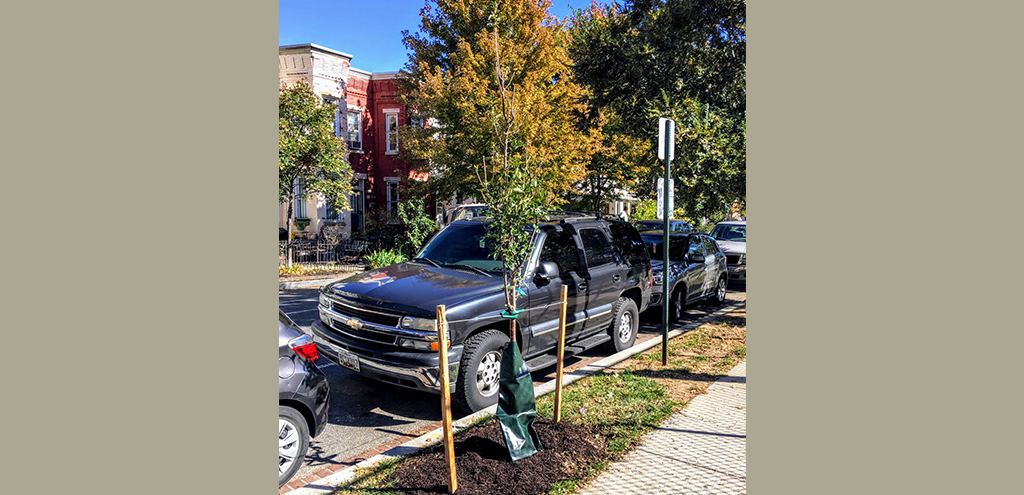
Street trees are, thanks to a lot of hard work, a ubiquitous part of city life. As a public resource, street trees depend on everyday citizens to monitor and care for them. But how often have we stopped to really inspect these hard workers? Let’s get to know our neighbors, shall we?
Starting from the bottom:
- Placement: When we say street trees, we’re referring to trees planted (typically) in tree boxes within the right of way, the area between the sidewalk and the street. Street trees are owned and maintained by the city’s Urban Forestry Division of the District Department of Transportation. That means if you want to plant in a tree box, remove a dead tree or prune an existing tree, you need to either be a city arborist or have a Public Space Tree Permit. You can submit requests for arborists and permits easily through 311.
- Soil: Soil, and especially healthy soil to establish trees and greenspaces, is having an increasingly tough time in DC. Due to our exploding population and building boom, an increasingly large portion of DC’s land is covered by concrete and asphalt. More hard surfaces means more stormwater runoff, increased pollution, and related impacts to the city’s already compromised streams and rivers. This is exactly the reason why last year we launched the Save Our Soil campaign to ensure a green, lush future for DC and not a gray, concrete-covered one.
- Roots: A tree has roots to anchor it, draw in nutrients and water from the soil, and help stabilize the soil and prevent erosion. A common misconception is that tree roots grow down into the ground when in reality they’re more likely to be found in the top three feet of soil, in a large area surrounding the tree.
- Mulch: A critical and often overlooked part of tree care, mulch is an essential tool. When applied properly, mulch can greatly benefit street trees by controlling weeds and grass, maintaining moisture in the soil and keeping trees hydrated, and protecting the roots and trunk from mowers and other lawn maintenance tools. Unfortunately, poor mulching techniques – namely the “volcano” – have recently been popping up all over the District. Improper mulching techniques can lead to rotted roots, dead bark tissue, insect problems, and imbalances in the soil’s pH levels.
- Root Flare: The root flare has been described as the heart of the tree. It’s where the trunk meets the supporting roots of the tree in an often wide and flared manner. When the root flare is planted too deep in soil or mulch, the tree can develop girdling roots and end up strangling itself. Proper placement and planting is why street tree planting is left in the hands of knowledgeable city arborists!
- Tree Guard: While they may not be on every street tree, tree guards are installed at the base of newly planted trees to keep its nutrient and water system from being cut. Trunk guards also protect trees from lawn maintenance equipment, rodents, and other small animals.
- Trunk: You can get really detailed when discussing a tree’s trunk, but for the most part, it’s the main woody stem of a tree. It’s made up of many layers of cells adapted for strength, resistance to injury and decay, transport of liquids, and storage of starch and other materials.
- Watering Bag: Newly planted trees, those planted within the past three years, require regular water and care to thrive. The large green bags that surround a street tree’s trunk are filled with water (from conscientious neighbors like you!) and slowly release it, helping the tree establish and thrive. Since they surround a street tree’s trunk, they can also protect it from impact wounds and dogs.
- Stakes: Depending on the street tree you may see two or three wooden stakes. While these certainly help give the street tree some structure, in reality, we like that they create a visual boundary around the tree, protecting it from people and vehicles.
- Branches: While they make up the crown, help shade sidewalks, driveways, and patios, and are a vital part of a street tree’s function when in ill health branches can also become hazardous to humans. Pruning a young tree can make or break its future, which is why only city arborists, those who’ve obtained a permit can perform any necessary pruning. Pruning branches is not just trimming the dead and dangerous away though, regular pruning also encourages a healthy tree structure.
- Crown: A street tree’s crown is what we love best-all of its collective stems, leaves, and branches. This is the part of a tree that collects rain and keeps you dry, shades you on hot summer days, keeps you cool, and filters the air, among many other benefits.
There you have it! You can dive further into your street tree neighbors with our Trees Near Me map, which highlights the species, size, and location of practically every tree we have data for. Don’t have a street tree outside your apartment, house, or office? Request a street tree planting through 311. Have a full street and want a tree on private property? We can plant trees for free. See a street tree that needs some TLC? Let a city arborist know. See a tree on private property that needs some TLC? Our arborists can take a look. Want to up your own tree care game? Check out our online store.
Article photo via DDOT’s Twitter.

